Rendang Daging is beef stewed in coconut milk with spices until all of the coconut milk has been reduced and the beef is tender. The stew becomes more and more dry, and turns from a light color to a dark color because of the caramelization that will occur. Rendang is traditionally served at festive occasions. The cooking method was developed to preserve meat in a tropical climate before refrigerators were available. Now rendang is still prepared because it is loaded with flavor. Rendang is so popular that it is regarded the national dish of Indonesia.
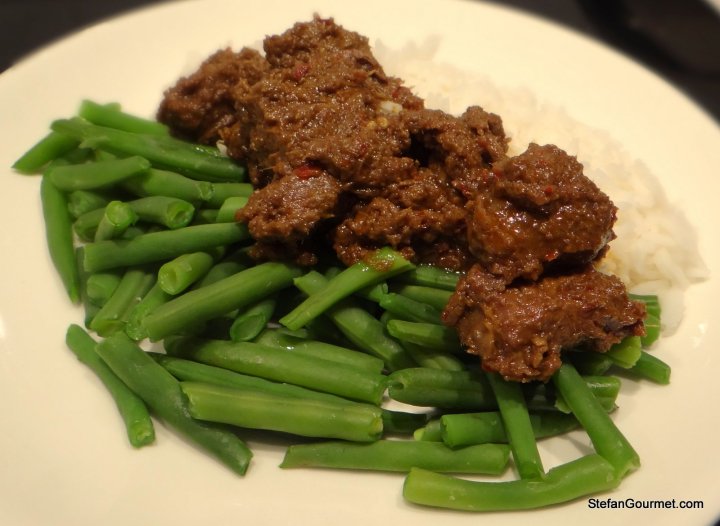
Like with many traditional recipes, there is no single recipe and every family has its own recipe. Don’t worry if you can’t find an ingredient, just omit it. Indonesian food is quite popular in the Netherlands for historic reasons, and Rendang is one of the better known dishes. Rendang is quite easy to make, the only thing to worry about is that you need to stir often enough towards the end as the sauce thickens. Rendang is the only stew recipe I know for which the browning occurs at the end instead of at the beginning. The spice mixture is traditionally made with mortar and pestle, but a blender works fine and is a lot easier. This was the first time I made it, and I liked the result very much. I will definitely make this again.
Ingredients
350 grams (.8 lb) stewing beef, according to my butcher flank steak is the best cut
1 Tbsp sambal oelek (Indonesian chili paste)
1 can (400 ml, 1 2/3 cup) coconut milk
2 cloves garlic, chopped
1 onion, chopped
1 fresh red chile pepper (or more if you like it very spicy)
1 lemon grass, chopped (sereh)
1 Tbsp chopped ginger
1 Tbsp chopped galangal
1 bay leaf (an Idonesian bay leaf is better if you can find it, salaam)
1 kaffir lime leaf (may be dried, djeroek poeroet)
1/2 tsp ground cumin
1/2 tsp ground coriander
1/8 tsp ground cloves
1/8 tsp ground turmeric
1/8 tsp trassi (Indonesian fermented shrimp powder)
1/4 tsp palm sugar (or brown sugar, gula djawa)
salt to taste
vegetable oil
Preparation
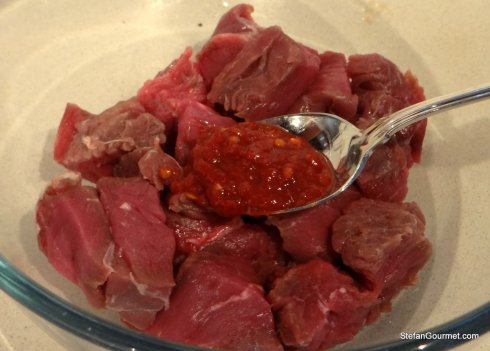
Cut the meat into cubes and add the sambal oelek.
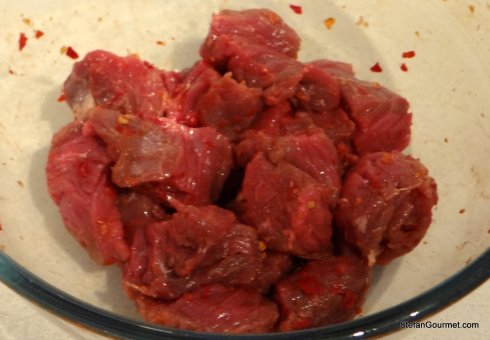
Stir until the meat is coated with the sambal.
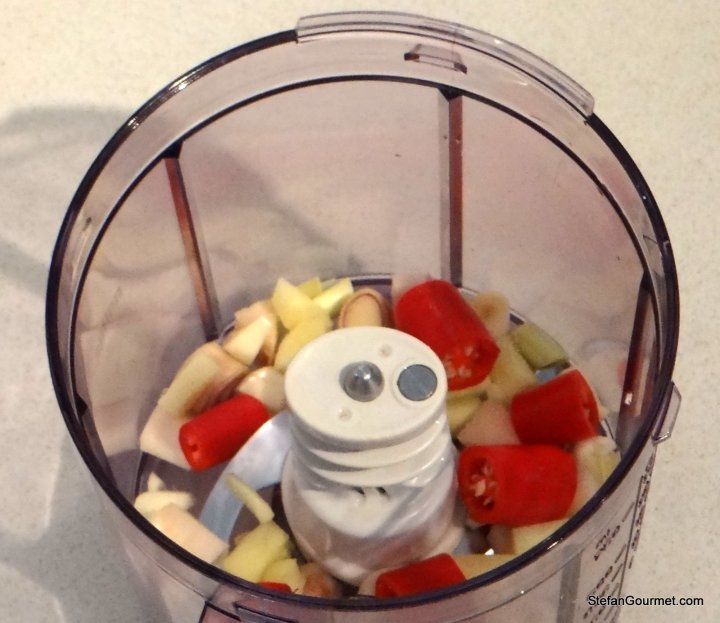
Combine the onion, garlic, lemon grass, chile pepper, ginger and galangal in the blender.
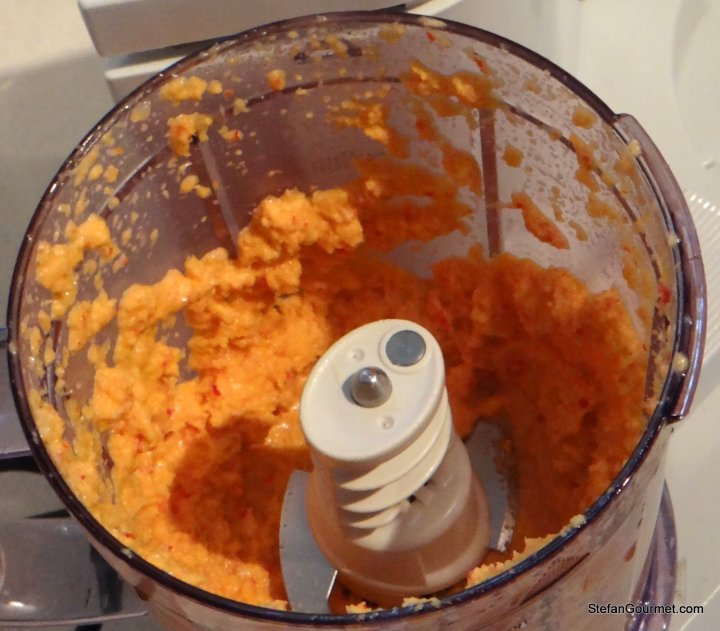
Blend until smooth. Add some oil if needed to get things going. Add the cumin, coriander, cloves, turmeric, and trassi.
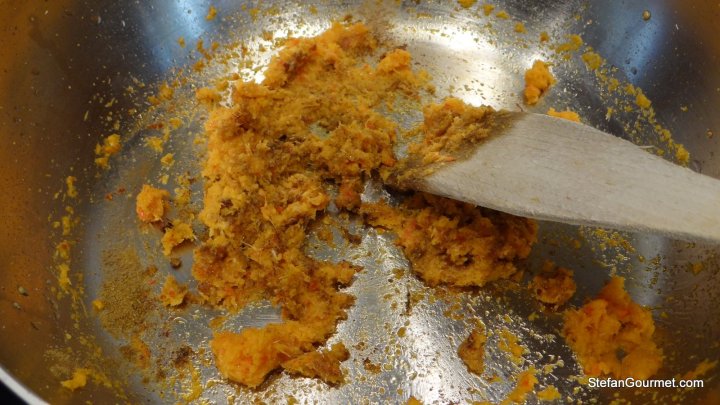
Heat some oil in a casserole (Dutch oven). Add the spice mix and sauté for a minute.
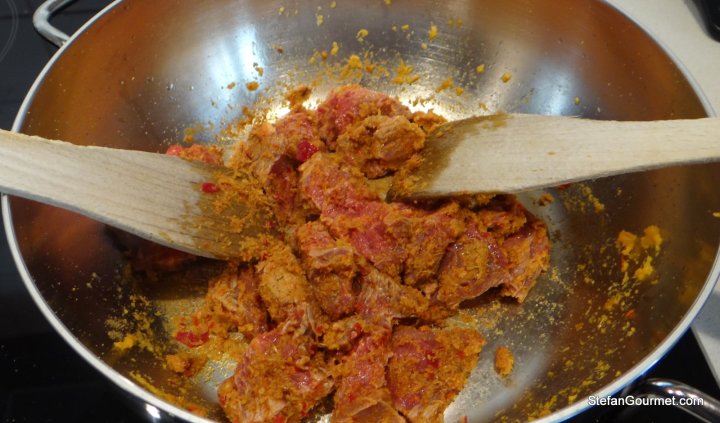
Add the meat and toss to coat with the spice mix.
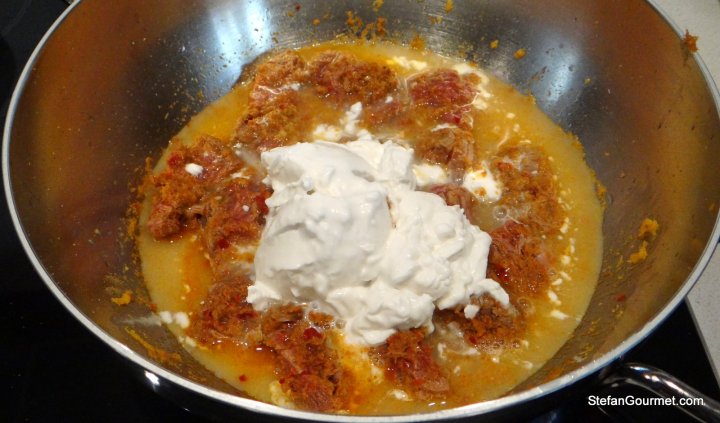
Add the coconut milk (which I should have shaken first).
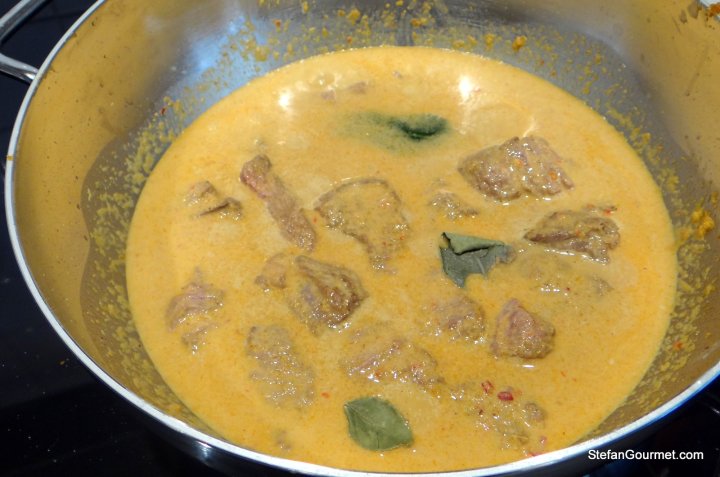
Add the kaffir lime leaf, bay leaf, and palm sugar. Bring to a boil.
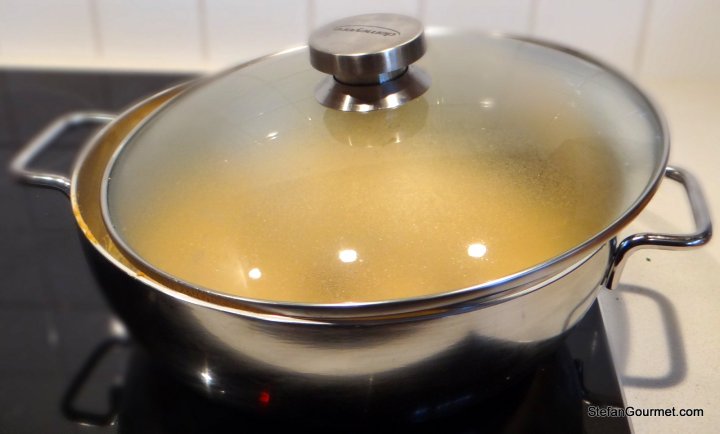
Lower the heat to a mere simmer and partially cover the casserole.
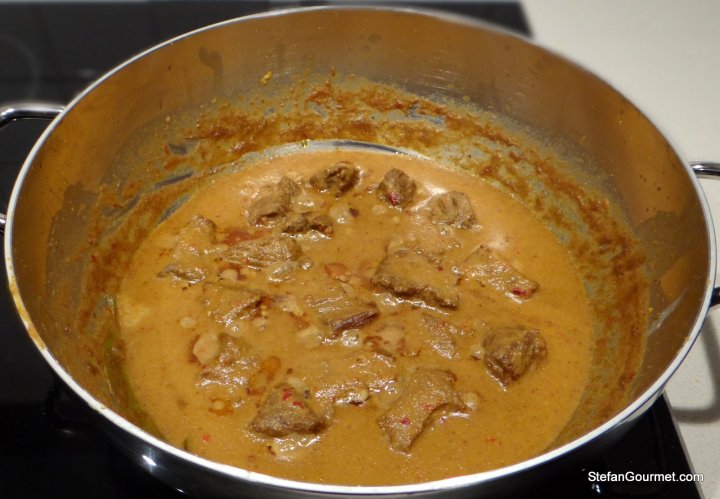
Allow to simmer over low heat for about 3 hours, stirring now and then.
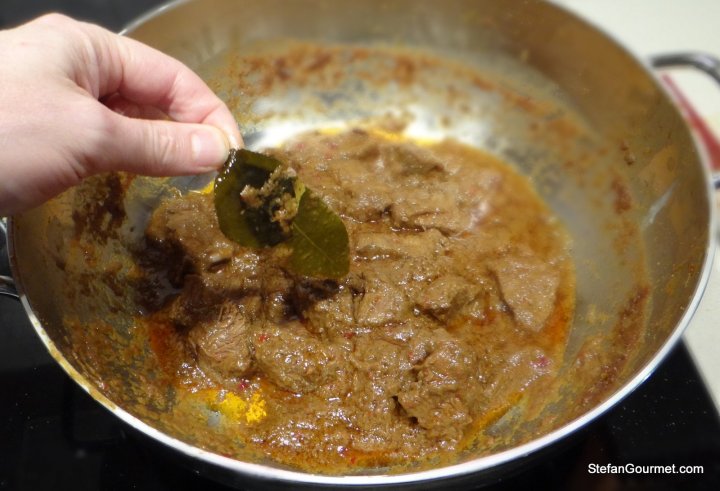
At the end of the cooking, remove the bay leaf and the kaffir lime leaf.
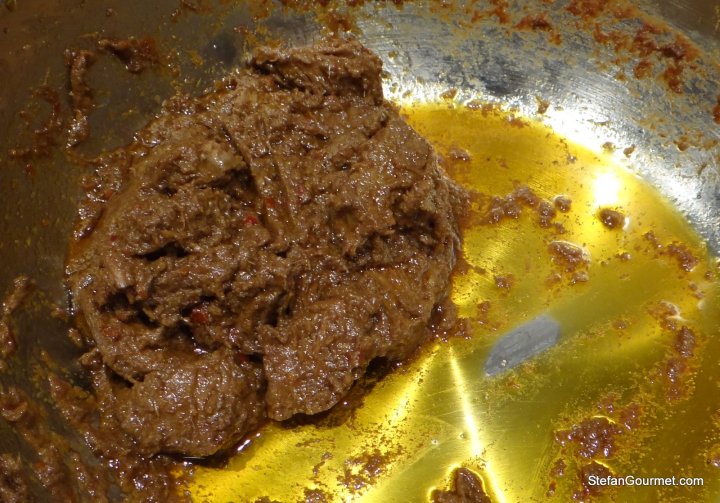
The sauce should have browned nicely. The sauce may separate a bit, that is quite normal. If you use very low heat it should be possible to avoid it, but I had no such luck on my first try. It still came out great.

Serve with white rice and green beans.
Wine pairing
This pairs well with a full-bodied ripe red from a very sunny climate, such as a Salice Salentino Riserva Selvarossa, Cantina due Palme.
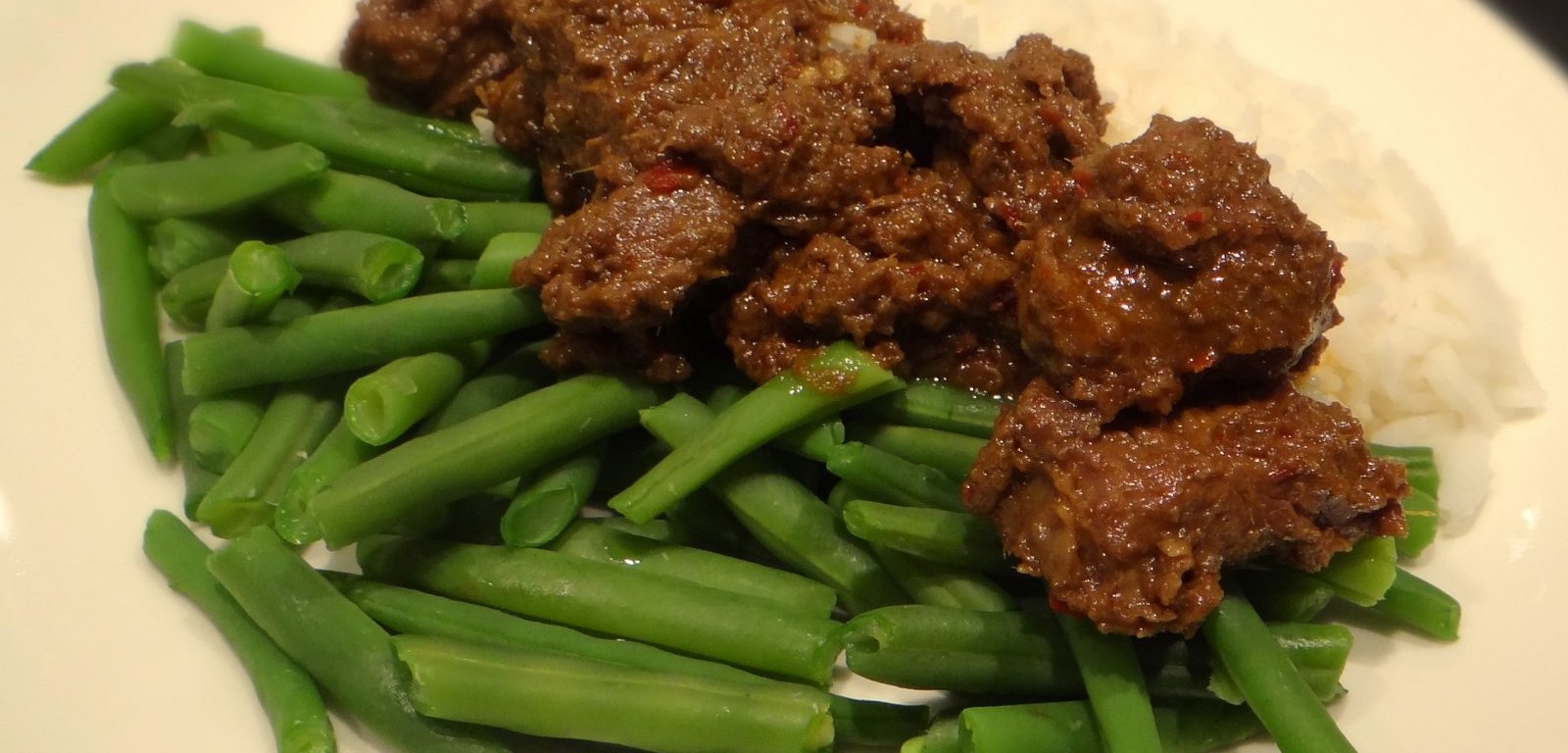
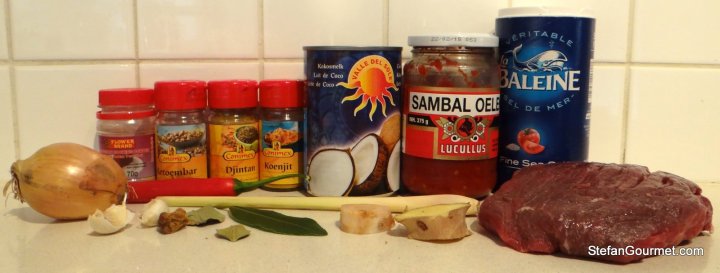

This truly is one of my favourite SE Asian dishes and not just for holidays: would cook it at least 1-2 a month. Yours is a lovely recipe and I do like that you have just the beans as a side dish, tho’ many would expect one of the rice forms also. However these days Beef rendang is regarded much more a Malaysian dish [have had it served in doxens of private homes there] and even Thai . . . perhaps because there is more travel from here>there than to Indonesia . . .
LikeLike
I do have plain white rice in there, although you can hardly see it on the photo 😉
Rendang is originally from Indonesia, but it has spread all over the region because it is so good.
LikeLike
Delicious! We love Beef Rendang in our house. My recipe is quite complex compared to yours, though the method is exactly the same. I’ve set this aside to try soon.
LikeLike
So what are the differences? (I haven’t looked on your blog — is it there?)
LikeLike
Ooooo after looking at my Rendang recipe, I see that I simplified the original significantly so I have to rescind my comment. Still say Rendang is delicious though. Here’s the link http://wp.me/p2frs2-op 😉
LikeLike
Excellent! I think you could write an ‘algorithm’ for a Rendang:
– Brown meat with spice blend of choice
– Simmer slowly with coconut milk until the milk caramelizes and oil begins to separate out.
– Serve
🙂
LikeLike
Indeed 🙂 The first step doesn’t really brown the meat though, the coconut milk is added too quickly for that to happen.
LikeLike
Wow, Chef Stefan, I am truly impressed..all your Italian recipes I have been observing and enjoying sofar and now Rendang from West Sumatra..it looks tasty
LikeLike
Thanks!
LikeLike
On my list of “must cook”.
LikeLike
Good idea. Would love to hear how it turns out for you.
LikeLike
This is so much more my stuff than yours. I have to cook it.
LikeLike
🙂
LikeLike
It’s indeed an Indonesian (Minangkabau) dish. Don’t let any Malaysian or Thai convince you otherwise (even if their cuisines bear strong similarities to Indonesian).
Having some Indonesian heritage, Rendang is a dish close to my heart (and I don’t say that about just any Indonesian dish either). Your recipe looks pretty authentic (Jamie Oliver, you can learn a thing or two from Stefan here. Do take notice.) Main differences with the version I make are the ground coriander (I don’t use it, don’t think I will) and the cloves (which I must most definitely try).
Your rendang as served on the plate looks great. Visually, the only giveaway that it wasn’t made by a native Indonesian is the fact that you’ve served it with plain green beans!
LikeLike
Thanks for the nice comments 🙂 My original plan was to serve it with Indonesian spicy green beans, but when I checked the recipe for that I noticed it was so similar to the recipe for rendang that I decided against it to have something more ‘neutral’ on my plate.
LikeLike
Thanks Stefan, copied your recipe almost 100% and it was delicious! I used less than half of peppers and oelek because kids were invited too. I wonder whether more peppers would overpower. BTW The bavette suggestion did work really well.
It only took 2 hours, but with high temperature and heavy stirring at the end as I had to plate at a certain time. No separation of sauce took place.
Combined with stir-fried purslane, white rice, pickled cucumber and bought-in prawn crackers this makes a well-balanced meal without much effort.
Stefan, any reason you use coconut milk in stead of santen?
LikeLike
Hi Jeroen, great to hear you liked it and thanks for letting me know. Coconut milk and santen can be used interchangeably (if you add water to the santen). I haven’t tried them side by side, but I would guess that coconut milk tastes slightly better because it has not been dehydrated and then rehydrated again.
LikeLike
Found this recipe from he link on the new bean posting. Stefan – your recipes are well set out and make one interested in trying them.
If it is not sacrilege to a time honored technique could one use sous vide in some way if there is not the 3 hours to watch a stove top. There will not be the sauce reduction but could that all happen say in a much shorter time at the end?
LikeLike
Hi, thanks for visiting and taking the time to leave such a nice compliment.
I have wondered about preparing this sous-vide, but I haven’t tried it because it is not just the reduction but also the slow browning that is vital to this recipe. I suppose a quick reduction at the end could work with a lot of stirring to prevent burning and get even browning? Still that would not allow the flavors to marry as much. I suppose a slowcooker (which I don’t own) may help to cut down some of the stove tending.
LikeLike
Hi to you – and thank you for the response. I am fast becoming a regular visitor here now having discovered your trove of sous vide recipes. Sous Vide and me are having a love affair right now. Fortunately it is not an exclusive one!
I also thought about the slow cooker – though again the browning could be a problem. Will give it a try and let you know. Right now I am going to sous vide some lamb shanks – that recipe looks great.
LikeLike
If you are having a love affair with sous-vide then I suppose I’m married to it (for almost 4 years now) — but not exclusive either 😉
Lamb shanks sous-vide are awesome. Let me know if you’d like to cook anything sous-vide that is not yet on my blog — I always like new inspiration!
LikeLike
Hey Stefan,
I know you have a sous vide Rendang recipe too. Rendang in a slow cooker maybe the easiest way to make it, or am I wrong?
Have you tried making in a slow cooker? Slow cooker vs Sous vide, which one would be best for Rendang and similar dishes in your opinion and why? 😉
grt `Boris
LikeLike
Hi Boris, this depends on what temperature the slow cooker uses. If the temperature is higher than the 74C/165F I used here, the meat will not come out as juicy. Rendang in a slow cooker is certainly easier. I do not own a slowcooker myself, so I do not have any experience with using one.
LikeLike